Support strong Canadian climate journalism for 2025
British Columbia continues to approve major LNG projects but can the resulting climate pollution fit inside the province's climate targets?
The provincial government says the LNG projects will be compatible with legislated climate targets — but the more LNG pollution, the faster the rest of B.C. will need to cut back.
To understand how much new LNG climate pollution could be coming, and what that means for British Columbians, I've created a visual survey of the data.
B.C. climate challenge before LNG
To start with, let's look at the climate challenge B.C. faces before adding any LNG climate pollution to the mix.
My first chart below shows B.C.'s current emissions as a dark blue bar. It's divided into the major sectors of the economy.

You can see that the four biggest emitting sectors are roughly equal in size, at 10 to 11 million tonnes of climate pollution each (MtCO2e):
- transporting people
- transporting freight
- natural gas industry
- other industry
The chart also shows B.C.'s legislated climate targets for 2030, 2040 and 2050.
The upcoming 2030 target requires cutting emissions to forty per cent below 2007 levels.
So far, B.C. has cut emissions just three per cent. To meet the 2030 target B.C. will need to start cutting emissions more than ten times faster — a 37 per cent cut in the next decade. That will be extremely challenging even without adding a lot of new LNG emissions to the pile.
Adding LNG emissions makes a hard job harder
Emissions from LNG projects will come on top of B.C.'s current sources. These LNG emissions will increase the size of cuts the rest of B.C. has to make.
"The math is simple: adding a massive new source of pollution means we need to do far more to cut carbon pollution from our homes, from buildings, from our cars and trucks, and from other industries as well." says Clean Energy Canada's executive director, Merran Smith.
How "massive" could it get? Let's take a look at the potential emissions from the LNG projects already approved. After that we'll look at two more LNG projects that are lining up for approval.
LNG approvals so far
B.C. has approved four major LNG projects in the last few years.
In late 2015, B.C. approved a first major LNG facility — the LNG Canada export terminal near Kitimat. When fully built out it will produce 26 million tonnes of LNG (26 MtLNG) per year. In 2018, the project owners gave it the thumbs up, and construction has begun.
Then in 2016, B.C. approved two major pipelines to feed fossil gas from B.C.'s interior to future LNG facilities on the north coast — Coastal Gas Link Pipeline and Pacific Trails Pipeline. Combined, these pipelines are designed to carry enough fossil gas to produce roughly 45 MtLNG per year.
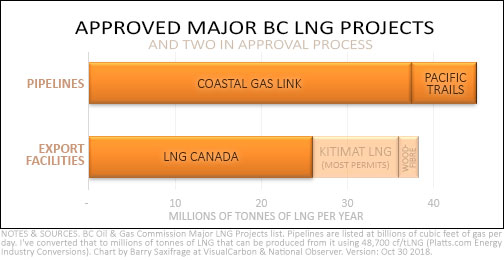
The Coastal Gas Link pipeline will feed the LNG Canada facility and has the go ahead from its owners. Construction has begun. The Pacific Trails pipeline is linked to the proposed Kitimat LNG facility which still needs one last major permit from the provincial government to proceed.
In 2017, B.C. granted approval for a second major LNG facility — the huge Pacific Northwest LNG facility near Prince Rupert. It was designed to compress 20 MtLNG annually while emitting nearly 11 MtCO2 per year. As we saw above, that's equal to the climate pollution from all of B.C.'s passenger cars, SUVs, trucks, trains and domestic flights. However, soon after gaining approval the proponents suspended the project. It still has valid environmental permits but would need to re-apply for its facility permit if the proponents decide to move forward.
Climate pollution from approved LNG
The approved LNG Canada project and its Coastal Gas Link pipeline are expected to emit roughly 9 MtCO2e per year when the project reaches its planned volume of 26 MtLNG per year. That's according to the project's Environmental Assessment and data from Pembina Institute.
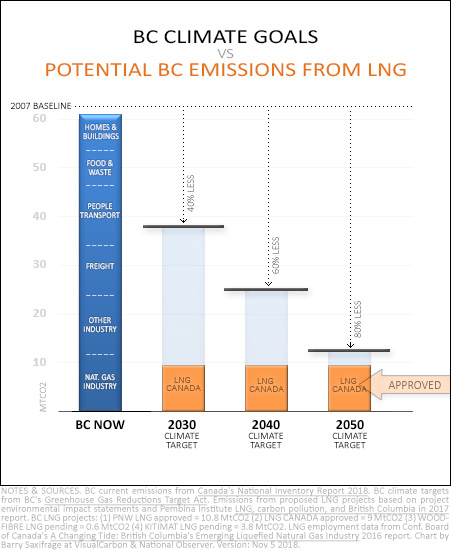
I've added LNG Canada's potential emissions to the original chart, as orange bars. As you can see, this one project could significantly reduce the climate budget for the rest of British Columbians.
The provincial government addressed this issue in their recently released Natural Gas Development Framework: "accommodating LNG Canada within our climate goals is possible, but will require that we make faster progress.”
Often the scale of emissions is put into context by tallying the number of cars that would need to be taken off the road to offset a project's climate pollution. In the case of LNG Canada, the number would be … all of them.
To offset the projected 9 MtCO2 from LNG Canada, British Columbians would need to stop driving every single fossil fuelled passenger car, SUV and truck in the province and replace them with new electric vehicles. B.C. will also need to build more clean electricity sources to power all these EVs. That’s obviously a major challenge that will involve nearly every British Columbian.
Even so, that effort would only prevent provincial emissions from rising. The required 40 per cent cut in B.C. emissions in the next decade would need to come from other huge cuts.
Climate pollution from two pending LNG projects
At least two more major LNG projects are coming up for approval: Kitimat LNG and Woodfibre LNG.
Both projects have all the major federal and provincial environmental permits they need. They also have federal export permits. In addition, Kitimat LNG has full approval for its Pacific Trails feeder pipeline. The only major permit each project still needs is a facility permit from the BC Oil & Gas Commission.
The larger of these two is Kitimat LNG, which would be located near the recently-approved LNG Canada facility. It has an export permit for 10 MtLNG per year. Emissions are projected to be roughly 4 MtCO2 per year.
The smaller Woodfibre LNG project aims to compress over 2 MtLNG annually and is expected to emit 0.6 MtCO2 per year doing that. The company president told the Financial Post recently that "we’re looking for a notice to proceed to construction in Q1 (of 2019)."
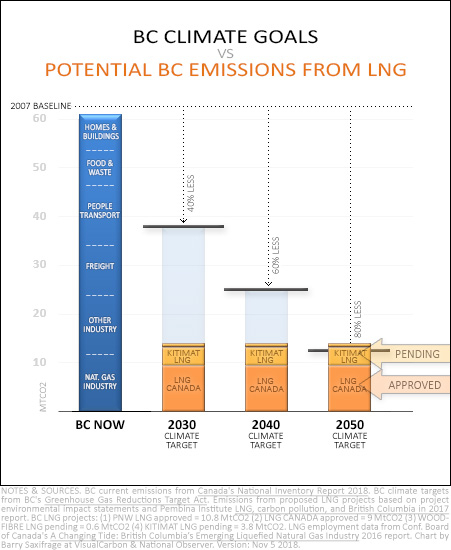
To illustrate what approval of these two projects could mean I've added their potential emissions to my chart as yellow bars. Combined, the projected emissions from these two pending projects is another 4.5 MtCO2.
To offset 4.5 MtCO2, every home and apartment in B.C. would need to stop burning fossil natural gas and switch to all electric heat. In addition, B.C. would need to create enough new clean electricity sources to power all these newly-electrified homes.
To appreciate the scale of this challenge, consider that the amount of fossil gas energy burned for heat in the city of Vancouver alone (7,000 GWh) exceeds the projected energy output from the gigantic Site C dam (5,000 GWh) that is under construction.
Adding huge new sources of climate pollution, like these proposed LNG projects, will require huge efforts by others just to keep emissions from rising.
Will the B.C. government approve these two pending LNG projects as well? I asked BC Ministry of Energy, Mines and Petroleum Resources: "Does the BC government require, as part of the approval process, that the emissions from any proposed LNG project fit inside BC's legislated climate targets?"
They responded that "LNG development in BC must fit within BC’s climate goals. That is not negotiable."
As my chart shows, climate pollution from all three LNG projects are less than the overall provincial goals … at least until 2050. But to meet those climate goals the rest of B.C. would need to squeeze itself into a much tighter climate budget.
Adding in the rest of B.C.'s fossil gas industry
As noted above, B.C.'s fossil natural gas industry already emits around 11 MtCO2 per year without LNG.
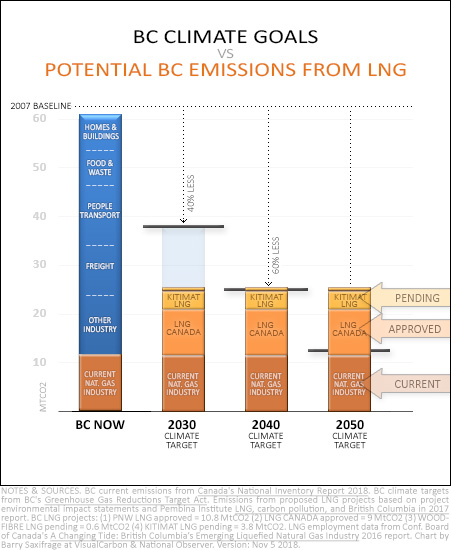
I've marked this with a brown bar in the first column of my chart.
I've also added these emissions to the future columns. Combined with the three LNG projects, B.C.'s fossil gas industry could take up two thirds of the province's climate target by 2030.
As the chart makes visually clear, choosing to significantly increase climate change emissions in the face of a plunging emissions budget leaves less and less for everyone else.
For example, in the 2030 scenario shown in the chart, British Columbians would have to do the equivalent of making every passenger vehicle electric and shutting off the gas lines to every home — just to offset the rise in pollution from the new LNG industry. And then, to meet B.C.'s climate goals, the rest of the provincial economy would have to cut emissions by two-thirds in the next decade.
The B.C. government says it has a plan that will make it all work out. They claim that the fossil gas industry can dramatically expand extraction, compress billions of cubic feet of gas per day, and send it off on super-tankers … all while dramatically slashing emissions from the rest of B.C.'s economy and citizens.
It is certainly good news for the B.C. fossil gas industry. Whether this path turns out to be good news for the vast majority of British Columbians who don’t work in that particular industry is yet to be seen.




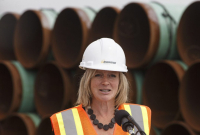

Comments
Mr. Horgan has become unhinged. It is his intent for those of us who switched to natural gas with both government and BC Hydro's blessing to switch to the two tier BC Hydro gouging expense in order for him to justify selling our gas to the world. A bonus for him is being able to say, "See, we do need Site C after all." How many of us now have gas furnaces and fire places that will effectively become redundant? We will watch our energy needs skyrocket in order for John to pollute and keep big oil and gas happy. DISGUSTING!
LNG/Fracking is simply wrong. One day our planet will be done ....because of greed.
David...the phrase “our planet will be done” is not accurate. Our planet will remain, albeit radically transformed. It is the various life forms attached to it that will be done. In the words of EO Wilson...all biological processes are obedient to physics and chemistry. The long term consequences to our society will be devastating.
I stand corrected. Thank you.
Another great column Mr. Saxifrage...good to see your analysis and insight again.
It's like this: I'll have to set the thermostat in my house at 5C, and shiver all winter, just so my neighbour can go out and buy a Hummer that he'll leave idling in his driveway all the time.
Yep, makes a lot of sense.
...or just so Mr. Trudeau can purchase a pipeline and congratulate B.C.'s Premier on the burgeoning LNG/Fracking industry.....or just so taxpayers pay another tax while big oil and gas receive a carbon tax vacation and government subsidies that would make loan sharks blush.
in other words, WE, not the planet, are so fracked...
…. as we keep driving our big SUVs towards extinction
The amount of greenhouse gas emission depends on the technology used. If only electrical energy from a renewable source were to be used for ‘mining’ the natural gas, transporting it and liquefying it, and if there were to be no methane released to the atmosphere, then there would be no greenhouse gas emission. It could be done, but I am not optimistic.
It would be good to know what technology was assumed in arriving at the numbers in the article.
Wow, how one sided can anyone get? Pull a Trudeau and selectively ignore the downstream benefits of having CNG replace coal and oil power plants. It might come as a complete shock, Saxifrage, but natural gas is a cleaner source of energy. Trudeau intentionally dumped on the petroleum industry and the Energy East line, adding theoretical upstream and downstream effects but then conveniently ignored the massive horrible upstream and downstream hazards of vehicle manufacturing. Using the Trudeau / Horgan way of thinking, the entire automobile manufacturing industry in Canada should be shut down immediately. A lot of pollution is created in acquiring the various materials used in vehicles and the effects of decades of operation of those vehicles must also be included. Selective hypocrisy.
Kudos on your research, but you left a lot out.
Fortis makes renewable biomethane available for customers to purchase. This comes from landfills, manure from dairy farms, organic waste, etc. Fortis has made this gas available at a very reasonable price, and hopefully enough people will sign on to make it more cost effective. Signing on to include 50% or 100% renewable gas costs very little. We should be willing to make this small sacrifice, as we expect industry and government to do all the heavy lifting. Biomethane does the job just fine.